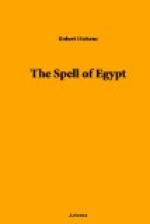In Coptic churches there is generally a great deal of woodwork made into lattices, and into the screens which mark the divisions, usually four, but occasionally five, which each church contains, and, which are set apart for the altar, for the priests, singers, and ministrants, for the male portion of the congregation, and for the women, who sit by themselves. These divisions, so different from the wide spaciousness and airiness of the mosques, where only pillars and columns partly break up the perspective, give to Coptic buildings an air of secrecy and of mystery, which, however, is often rather repellent than alluring. In the high wooden lattices there are narrow doors, and in the division which contains the altar the door is concealed by a curtain embroidered with a large cross. The Mohammedans who created the mosques showed marvellous taste. Copts are often lacking in taste, as they have proved here and there in Abu Sargah. Above one curious and unlatticed screen, near to a matted dais, droops a hideous banner, red, purple, and yellow, with a white cross. Peeping in, through an oblong aperture, one sees a sort of minute circus, in the form of a half-moon, containing a table with an ugly red-and-white striped cloth. There the Eucharist, which must be preceded by confession, is celebrated. The pulpit is of rosewood, inlaid with ivory and ebony, and in what is called the “haikal-screen” there are some fine specimens of carved ebony.
As I wandered about over the tattered carpets and the crumbling matting, under the peaked roof, as I looked up at the flat-roofed galleries, or examined the sculpture and ivory mosaics that, bleared by the passing of centuries, seemed to be fading away under my very eyes, as upon every side I was confronted by the hoary wooden lattices in which the dust found a home and rested undisturbed, and as I thought of the narrow alleys of grey and silent dwellings through which I had come to this strange and melancholy “Temple of the Father,” I seemed to feel upon my breast the weight of the years that had passed since pious hands erected this home of prayer in which now no one was praying. But I had yet to receive another and a deeper impression of solemnity and heavy silence. By a staircase I descended to the crypt, which lies beneath the choir of the church, and there, surrounded by columns of venerable marble, beside an altar, I stood on the very spot where, according to tradition, the Virgin Mary soothed the Christ Child to sleep in the dark night. And, as I stood there, I felt that the tradition was a true one, and that there indeed had stayed the wondrous Child and the Holy Mother long, how long ago.
The pale, intelligent Coptic youth, who had followed me everywhere, and who now stood like a statue gazing upon me with his lustrous eyes, murmured in English, “This is a very good place; this most interestin’ place in Cairo.”
Certainly it is a place one can never forget. For it holds in its dusty arms—what? Something impalpable, something ineffable, something strange as death, spectral, cold, yet exciting, something that seems to creep into it out of the distant past and to whisper: “I am here. I am not utterly dead. Still I have a voice and can murmur to you, eyes and can regard you, a soul and can, if only for a moment, be your companion in this sad, yet sacred, place.”




